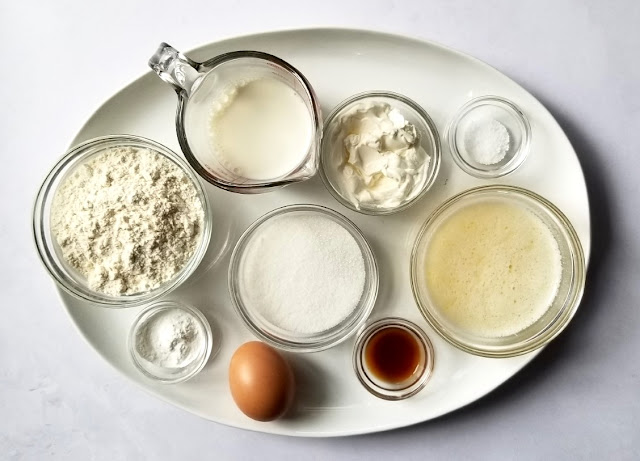In less than a week I head out west to Colorado. And I have already started packing. A clear indication I couldn't be more excited to spend time hiking in the mountains. Even if many of the trails are still snow packed. Here I thought I would be experiencing a Colorado spring on this trip, but instead it seems as if it might look and feel a bit more like winter. Which means by the time I am ready to head out to the airport I will have overpacked. Although truth be told there has never been a trip where I didn't overpack. Only this time I can put some blame on the weather. How anyone can go on a week long adventure and take only one bag never ceases to amaze me.
In many ways I approach my charcuterie boards the same way I do packing my luggage. More is always better. Always.
The star of this black and blue themed charcuterie board is the Balsamic Rosemary Blueberry Jam as it is an ideal compliment to creamy double/triple cream brie, to a soft, tangy chevre, and to a sharp, slightly pungent blue cheese. It also happens to be insanely good.
In less than 20 minutes (plus some cooling and chilling time) you can make a small batch of this Balsamic Rosemary Blueberry Jam. Because it is made with only seven ingredients, the entire flavor profile of this jam is elevated. In a single spoonful you will detect the tartness of lemon juice and balsamic vinegar, the sweetness of the honey, sugar, and blueberries, the aromatic rosemary, and just a hint of salt. This jam is a virtual dance party on your palate!
Besides having good ingredients, two of the keys to making a really good jam is using a heavy bottomed saucepan and letting the jam first come to a boil then simmer until it has the perfect jammy consistency.
One of the ways I test for the jam's doneness is to dip a spoon in the cooking jam, then swipe my finger down the back of it. If the finger swipe remains, the jam is ready to be removed from the heat.
As soon as the jam is ready, it should be transferred to a heatproof jar so it can cool to room temperature. If you allowed the jam to cool in the saucepan, the heat will adversely affect the jam's viscosity. The jam can be served warm or chilled. It's incredibly delicious either way.
The contrasting colors on this charcuterie board gives it that 'wow' factor. Making it one everyone will gravitate toward as well making it hard for everyone to resist digging in! Paired your 'house' cocktail or favorite wine, this charcuterie board makes for an incredibly impressive appetizer.

So what are some of the secrets to making a great charcuterie board? Well, first it's one having three or four critical components: cheese, charcuterie (meats), crackers/bread, and accoutrements (fresh and/or dried fruit, nuts, honey, and jams). This one only has three but the three selected are amazing. The second secret comes to choosing your cheese. Always think in terms of odd numbers: one, three, five or seven. Also think of the variety (firm, semi-soft, creamy, crumbly, smoked and/or stinky) as well as the compatibility of each cheese. This board uses three differently flavored and textured cheeses, however, they all work well with one another, but especially with the Balsamic Rosemary Blueberry Jam!

Last, but not least, is the arrangement. The most beautifully arranged boards are the most inviting boards. So fill it up. Or as I like to say 'overpack it'. Using small bowls for nuts and jams and/or jars for honey, not only create some visual interest, they are easy to replenish. To cut or not to cut the cheeses is always a question I ask myself when putting together a charcuterie board. And there is no absolute right or wrong answer. I will say it depends in part on the number of people you are serving as well as the density of the cheeses. For harder cheeses, like a gouda or parmesan, I like to cut them at least 2/3s of the way through. I generally don't cut the softer cheese, like brie or chevre, as the slices sometimes stick together. But that too isn't a hard and fast rule.
A fabulous charcuterie board doesn't have to break the bank. Yes, good quality cheeses and crackers can be expensive. With a few exceptions, I often buy most of my cheeses from either the never disappoints Trader Joe's or Whole Foods. And if I can't find what I want there, then I am lucky enough to have a local grocery store with a great selection of cheeses.
There might be a few guidelines to building your version of an epic, gorgeous charcuterie board, but there are no absolute rules. Remember that. So get creative and have fun putting boards together than bring people together!
P.S. If you happen to have any of the Balsamic Rosemary Blueberry Jam leftover, it's fabulous spread on a piece of thick toasted bread spread with some whole milk ricotta cheese. Just saying.
Recipe
Balsamic Rosemary Blueberry Jam & A Charcuterie Board
Ingredients
Balsamic Rosemary Blueberry Jam
1 pint/2 cups fresh blueberries
1/2 cup (100g) granulated sugar
1 Tablespoon freshly squeezed lemon juice
1 Tablespoon balsamic vinegar
1 Tablespoon honey
1 scant Tablespoon freshly minced rosemary
1/8 teaspoon Kosher salt
Charcuterie Board
A wedge of Double or Triple Cream Brie Cheese
Small log of Chevre
A wedge of a good quality blue cheese
Black seedless grapes
Fresh blueberries
Fresh blackberries
Salted Roasted Cashews
Marcona Almonds
Honey
Dried cherries and/or cranberries
Assortment of crackers and/or crostini
Optional: edible flowers (e.g., pansies) for decoration
Directions
Balsamic Rosemary Blueberry Jam
1. In a heavy bottomed saucepan, add in the blueberries, sugar, and lemon juice. Over medium heat, cook until the sugar melts (approximately 3-4 minutes).
2. Add in the salt, honey, balsamic vinegar, and rosemary. Stir to blend. Bring mixture to a boil.
3. Reduce heat to low and continue cooking until the jam begins to thicken (approximately 8-10 minutes).
4. Remove from heat and transfer to a heat proof jar. Let cool completely before covering and refrigerating.
Charcuterie Board
1. On a large oval platter or round cheese board, place the cheeses in three locations.
2. Add a small bowl of the Balsamic Rosemary Blueberry Jam and small jar of honey.
3. Add a small bowl of the cashews a large handful of the marcona almonds.
4. Arrange the grapes, blackberries, and blueberries around the cheeses.
5. Add some dried cherries and/or cranberries.
6. Add in the crackers in various locations on the platter/board.
7. Top with several edible flowers.
8. Serve and savor!
Notes: (1) All of the cheeses were purchased from Trader Joe's. (2) While not used on this platter, my favorite blue cheese is the Point Reyes Blue. (2) All of the fresh fruit and nuts were purchased at Trader Joe's. (3) Use a good quality, small batch honey. (4) Instead of marcona almonds use roasted almonds or walnuts.
Morton Arboretum, Lisle, Illinois (May 2021)




























































